Imagine waking up on a Saturday morning, eagerly anticipating a peaceful day, only to discover an unexpected wet patch on your bed.
The realization that your dog has left an unwelcome surprise hits you. And the immediate question arises: “Why is my dog peeing on my bed?”
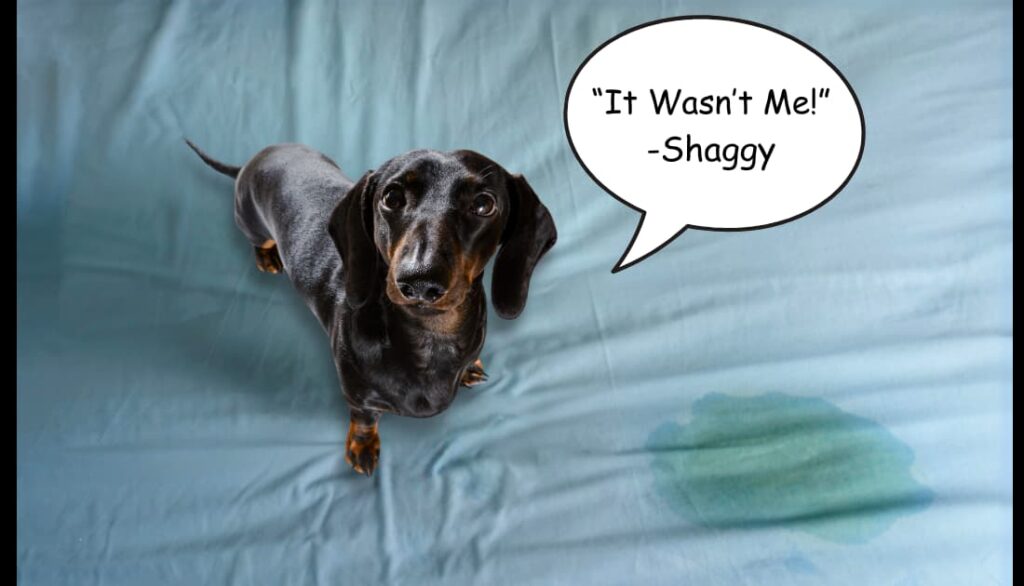
Before you jump to conclusions, it is important to note that dogs don’t think and act like humans. They don’t do things out of spite or for malicious intent.
There’s more to their “accidents” than meets the eye. In this article, let’s unravel the mystery behind canine bed-peeing, packed with insights and solutions to help your furry friend and bed stay dry!
- Common Reasons Your Dog Might Pee on the Bed
- 1. Challenges of Dog Training Puppies
- 2. Senior Dogs and Loss of Bladder Control
- 3. Marking Territory: Misunderstood Dog Behavior
- 4. Emotional Triggers: Stress, Anxiety, and Fear
- 5. The Link Between Boredom and Indoor Peeing Accidents
- 5. Submissive Urination (vs Excitement Urination)
- 7. Health Issues Behind Inappropriate Urination
- Strategies on How to Stop Your Dog From Peeing on the Bed
- Practical Potty Training and Behavioral Reinforcement
- Managing Senior Dog Incontinence
- Tackling Bed-Wetting Caused by Canine Territory Marking
- Managing Dog Pee Problems Arising From Fear and Stress
- Mental Stimulation as a Key to Stop Peeing Accidents
- Effective Steps to Ending Submissive Dog Urination
- Addressing Medical Needs: Working with Your Vet
- Long-Term Strategies to Keep Your Bed Dry
- Key Takeaways
- FAQs
- Is disciplining my dog okay if they pee on my bed?
- What causes dirty dog syndrome?
- How can I tell if my dog has an Urinary Tract infection?
- What measures can i take to prevent my dog from peeing inside?
- When should i be worried about my dog having urinary incontinence?
- Could my dog be urinating on my bed out of spite?
- Does rubbing a dog’s nose in their urine have a positive effect in training?
- How to scold my dog for peeing on my bed?
- How can I alleviate a dog’s urinary tract infection without veterinary assistance?
Common Reasons Your Dog Might Pee on the Bed
1. Challenges of Dog Training Puppies
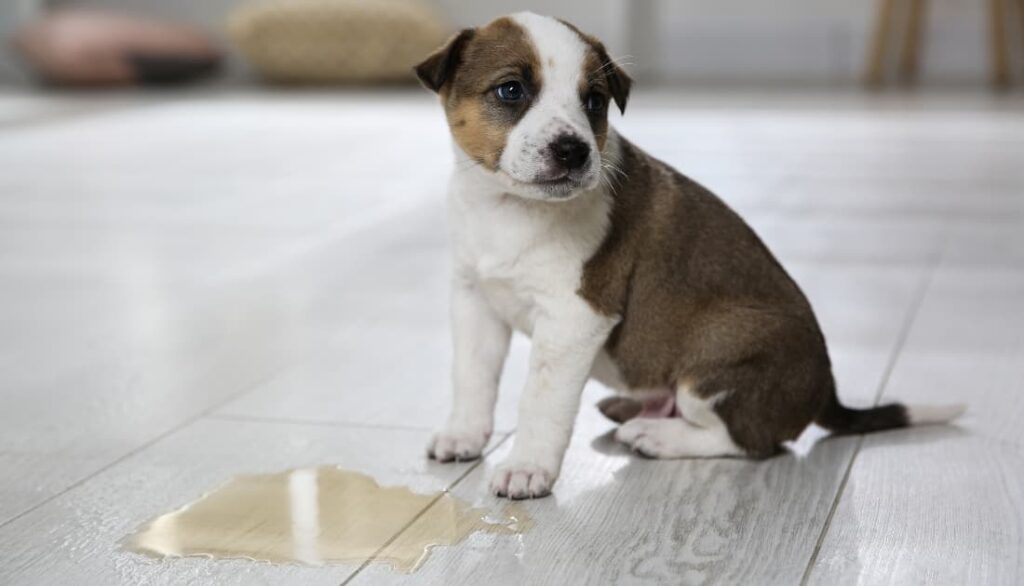
One of the primary reasons why your dog might choose to urinate on your bed is simply due to house training mishaps.
And I get it! Potty training your puppy can be quite a challenging process. It is like teaching a toddler about bathroom etiquette.
Canines, especially younger dogs, may need help understanding where they are supposed to go when nature calls. They may not be able to hold their urine for long since their bladders aren’t fully developed.
And if your puppy sleeps on the bed with you, they can mistake your bed for an acceptable spot to go potty. Because it provides a sense of comfort similar to that of a carpet.
But don’t take it personally! Be patient and expect potential accidents when your puppy is being potty trained. They are still learning to hold their pee and getting used to their designated potty areas.
2. Senior Dogs and Loss of Bladder Control
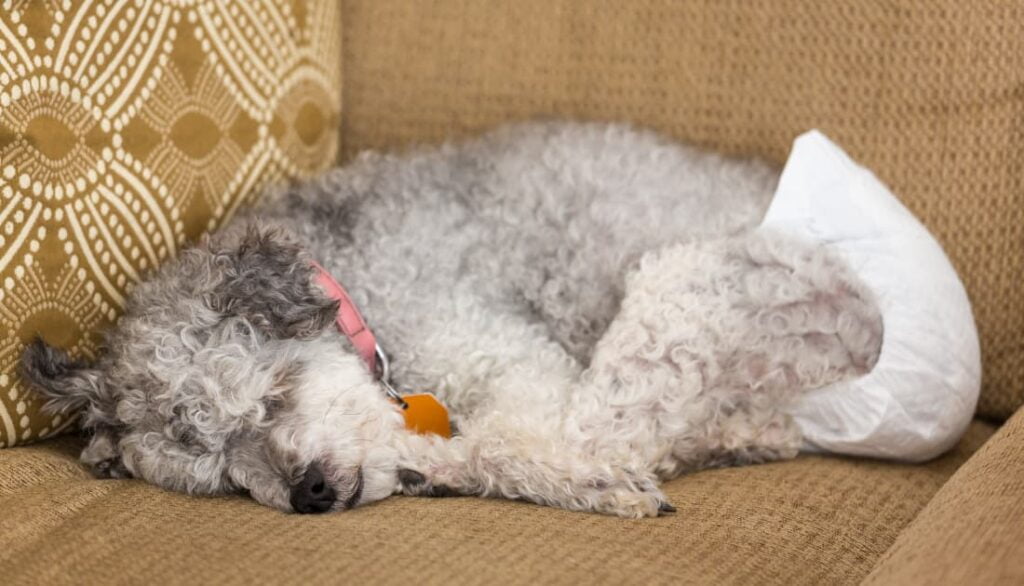
As our furry friends age, their bathroom habits may change. While some old dogs navigate gracefully, others face newfound challenges like incontinence.
Common causes of urinary incontinence include:
- Hormonal Imbalance.
- Cognitive Dysfunction Syndrome (Canine Dementia).
- Degenerative Spinal Cord Disease.
- Weakened bladder muscles.
This can present itself in different ways, from forgetting their house training to small leaks while they are resting on your bed.
Therefore, understanding these natural stages in your dog’s life is crucial. It allows you to address bed-wetting and provide the support your senior dog may need.
3. Marking Territory: Misunderstood Dog Behavior
We all know the joy of wagging tails and playful barks.
But our furry companions communicate far more than just with happy gestures. Beyond the surface lies a complex emotional language, often hidden in their behaviors.
A commonly misunderstood canine behavior includes territory marking.
Unlike the full-blown puddles left behind when your dog pees typically, dog marking involves tiny amounts of urine. Think of it as your pup’s stealthy signature to leave behind olfactory breadcrumbs.
And what may seem like a form of territorial behavior is a natural canine communication method. But why this cryptic communication?
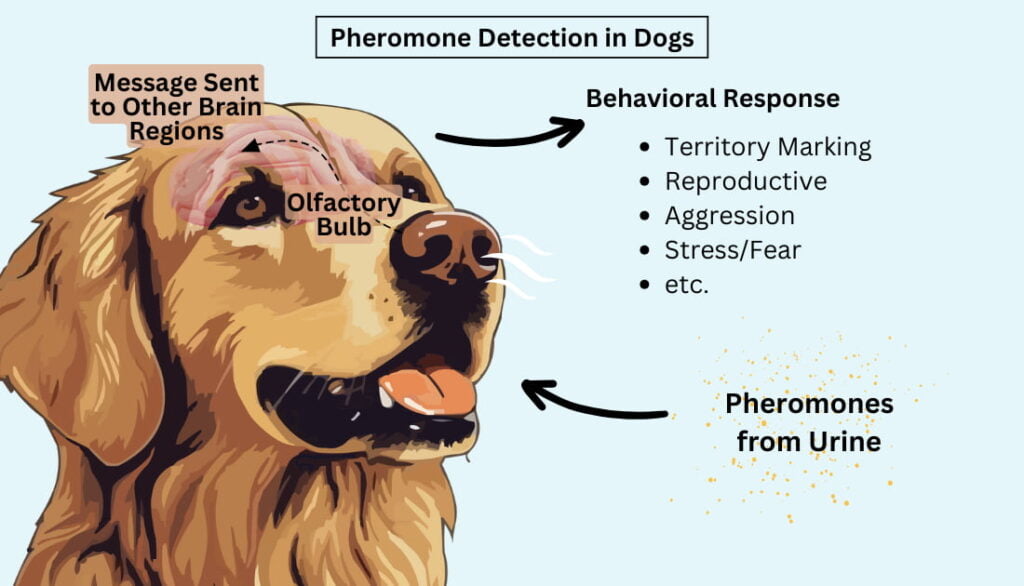
Research reveals that dog urine contains a mixture of pheromones (chemical signals) that carry unique information about them.
When dogs mark their territory, they relay this information (e.g., their presence, social status, emotions, etc.) to other animals in their environment.
“Scent marking is one of the main forms of communication in canids. It is crucial for territorial marking, synchronization of reproduction, establishment of hierarchies in groups, and formation of new breeding pairs.”
– (Stępniak et al., 2023)
Therefore, if your dog leaves a “gift” on your bed, it’s not a power play. It can be a subtle chemical message to other dogs, saying, “I was here.”
Based on this thinking, your comfy bed isn’t just a cozy snooze spot for your four-legged friend. To them, it’s an environment that contains the scent of their human companions and serves as an extension of their pack.
Thus, your dog may mark the bed on purpose to add their unique smell and signify their presence.
4. Emotional Triggers: Stress, Anxiety, and Fear
Dogs are generally tough and adaptable creatures, but they can still suffer from anxiety and stress, just like humans do.
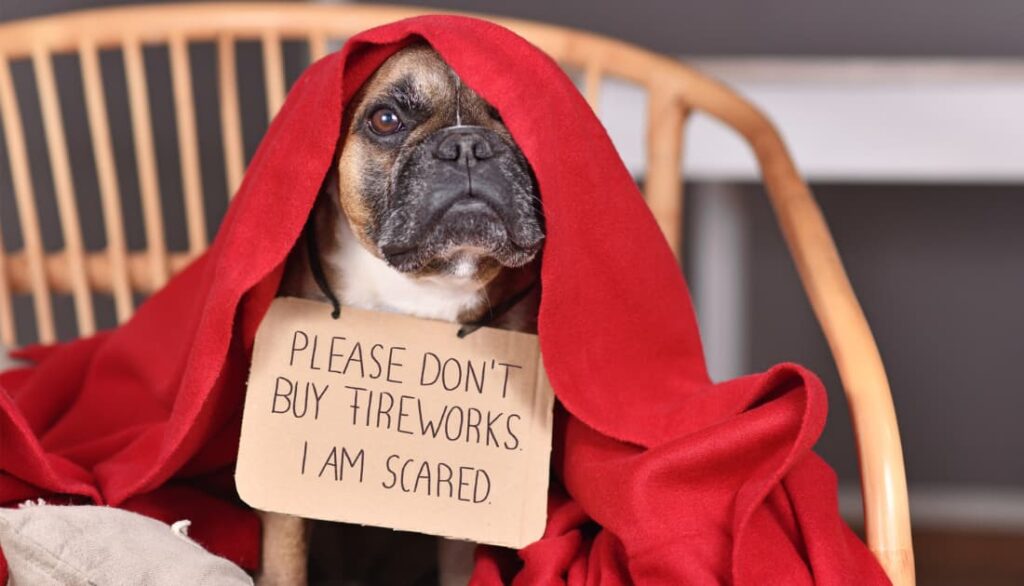
These negative emotions can be triggered by regular occurrences. These include a change in their daily routine, the loud noises of fireworks, or the unwelcome presence of a new pet.
| Anxiety Trigger | Signs | Behavioral Response |
|---|---|---|
| Loud and Sudden Noises | Trembling, hiding, whimpering | Seeking comfort on your bed, which may lead to urination |
| Separation Anxiety | Destructive behavior when alone, excessive barking or howling | Urinating on your bed due to distress when you’re absent |
| Changes in the Environment | Restlessness, loss of appetite | Selects bed as a familiar and comforting spot, resulting in peeing |
Sadly for our beloved canines, anxiety and stress can lead to behaviors that are considered out of the norm for our dogs, like inappropriate urination.
But why our beds? As dogs develop deep bonds with their human companions (a.k.a. us), they associate specific locations in the home with safety and security.
So, when stressed, their instinct may be to mark the place they feel most secure: your bed.
5. The Link Between Boredom and Indoor Peeing Accidents
As intelligent and mischievous creatures, dogs require physical and mental stimulation. They thrive on engagement, stimulation, and the comforting presence of their loved ones.
When your dog’s needs are unmet, boredom can cause your dog to resort to undesirable behaviors like peeing on your bed.
Think about it from your dog’s point of view. Spending long hours alone, taking the same predictable walks, and having limited playtime can make your pup feel isolated and bored.

As a result, they might try to get your attention, even if it means getting scolded for bad behavior. This is because they would rather have negative attention than no attention.
5. Submissive Urination (vs Excitement Urination)
While we express emotions through cheers, laughter, tears, and trembling, dogs communicate their feelings uniquely.
One such expression, often known as “happy pee,” manifests as excitement urination. Most commonly seen in puppies and adolescent dogs, this occurs when overflowing joy leads to a momentary loss of bladder control.
The good news? Excitement urination is a natural response that typically disappears as they mature.
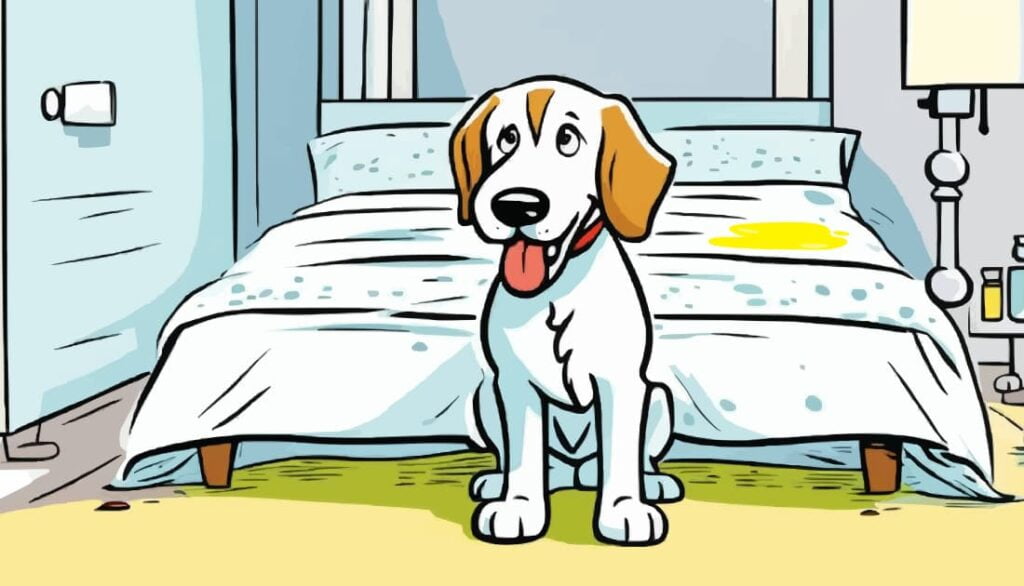
But not all pee puddles tell the same story!
When feeling scared or threatened, some dogs might pee to calm the situation and signal submission. This behavior is known as submissive urination.
This fear-inducing response can affect dogs of all ages and can be triggered by:
- Scolding
- Unfamiliar Situations
- A Stranger Approaching
- Punishment
- Deep/loud voices
- Feeling Overwhelmed
Note: Root causes of submissive urination can include trauma (past neglect or abuse), limited socialization during puppyhood, a history of negative physical punishment, or genetic predisposition.
So, how do you know if your dog is experiencing submissive urination?
Observe your dog’s body language. Look out for signals like flattened ears, a tucked tail, whimpering, and a lowered head or neck to suggest a stressed or frightened dog.
Thus, recognizing your pup’s body language can help you decipher these emotional “urine leaks.”
7. Health Issues Behind Inappropriate Urination
While occasional puddles during training or in older dogs are understandable, frequent or unusual urination warrants attention.
One possible reason behind these indoor mishaps, like bed-wetting, could be a urinary tract infection (UTI). UTIs are bacterial infections that irritate the bladder and urethra.
The infection can make your dog experience discomfort and feel an urgent need to urinate, sometimes unexpectedly. This overwhelming urgency can cause accidents, including urinating on the bed, even in well-trained dogs.
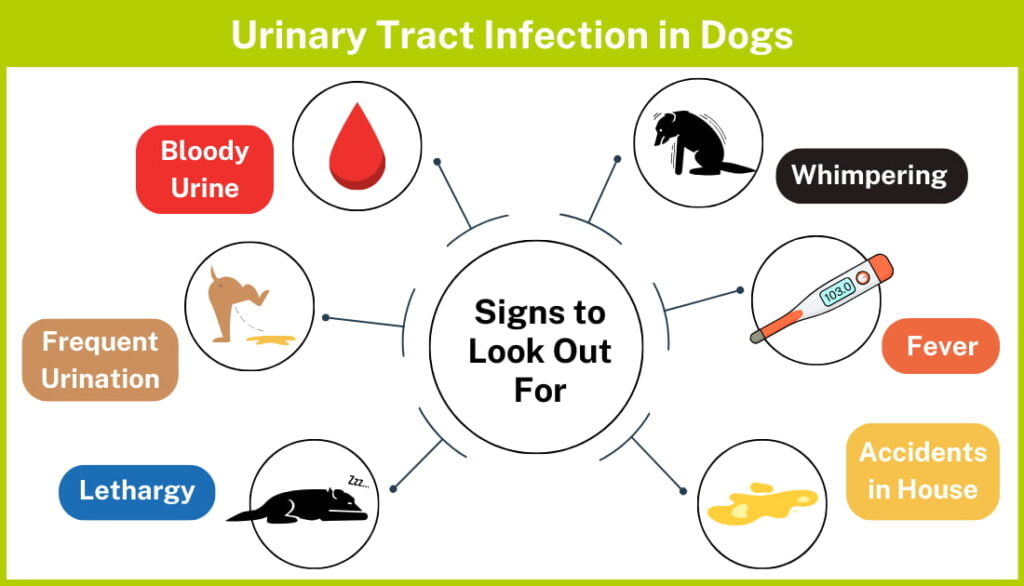
To catch a potential UTI early, keep an eye out for these unusual signs in your pup’s behavior:
- Straining to urinate
- Bloody or cloudy urine
- Foul-smelling urine
- Excessive licking of the genitals
- Visible discomfort
- Whining during urination
Although UTIs are a common cause of unusual bathroom habits in dogs, other medical conditions can make it difficult for your dog to stop peeing in the wrong places.
Canine diabetes: Affects your dog’s ability to regulate blood sugar levels. Elevated sugar levels increase thirst and water consumption, leading to increased urination.
Kidney disease: When the kidneys are not functioning correctly, filtering waste from the bloodstream becomes difficult. This waste buildup in your dog’s blood can trigger their body to flush them out through increased urination, even if your dog isn’t drinking more.
Bladder stones: These mineral deposits, big or small, can wreak havoc on your dog’s urinary tract. They can cause painful urination, straining, and blockage in dogs, leading to accidents both inside and outside the home.
Of course, these are not the only health issues that can affect your dog’s urination patterns. But it’s important not to ignore unusual urine puddles in pets, as they may require swift veterinary attention!
Strategies on How to Stop Your Dog From Peeing on the Bed
Practical Potty Training and Behavioral Reinforcement

Potty training your puppy can seem like a daunting task, but there are proven techniques that make the process more manageable.
For instance, I have found that establishing a consistent schedule is one of the most effective tools for successful puppy potty training. Ideally, puppies should be allowed frequent bathroom breaks throughout the day.
Rule of thumb? Puppies and young dogs must go out every hour for their age in months. So, a two-month-old puppy needs to go out every two hours.
Furthermore, make sure to celebrate your little one’s successes!
Positive reinforcement, such as giving treats or praise, is a great way to reward your dog for using their designated potty spot. This creates a more positive and stress-free learning environment for you to teach your dog successfully.
Ready for more tips? The chart below offers additional tips to help improve your canine’s toilet habits and make potty training a little easier.
| Potty Training Tips to Prevent Bed Wetting | How to Implement |
|---|---|
| Watch for Signs of Needing to Go | Look for sniffing, circling, squatting, or restlessness, and quickly take your puppy outside. |
| Limit Water Intake Before Bed | Make sure your puppy has water throughout the day, but take away their water dish about 2 to 2.5 hours before bedtime. |
| Use a Cue Word or Phrase | Use a cue word or phrase like “go potty” just before taking your pup outside. As they associate this word with going to the bathroom, they’ll understand what’s expected and even let you know when they need to go! From my own experience, I found this to be very effective. My dog understands the question, “do you need to go potty?” If he does need to pee, his tail will start wagging and he will guide me to the door. |
| Seek Professional Help | If all the tactics you have tried are not working, consult a veterinarian or professional trainer for guidance. |
Managing Senior Dog Incontinence
Consulting your veterinarian is vital at the first sign of changes in your pet’s bathroom habits, especially when it involves your senior dog and urinary incontinence.
They can diagnose the underlying cause and recommend effective treatments. This may include medication, dietary changes, or supportive equipment.
In addition to veterinary care, you can take proactive steps at home to alleviate the impact of urinary incontinence:
- Proper Hydration: Ensure your dog can always access fresh water. Dehydration can worsen incontinence.
- Supplements: When discussing your pet’s urinary health with their veterinarian, consider mentioning potential supplement options such as omega-3 fatty acids.
- Modify Living Spaces: Make living spaces puppy-proof by strategically laying out puppy pads for potential accidents and placing protective covers on furniture and bedding.
- Watch their Weight: Maintain a healthy weight for your dog through a balanced diet and regular exercise. Obesity can place more strain on the bladder, which worsens incontinence.
- Purchase Belly Bands and Diapers: You can use belly bands or diapers as a temporary solution to stop your dog from peeing on the bed.
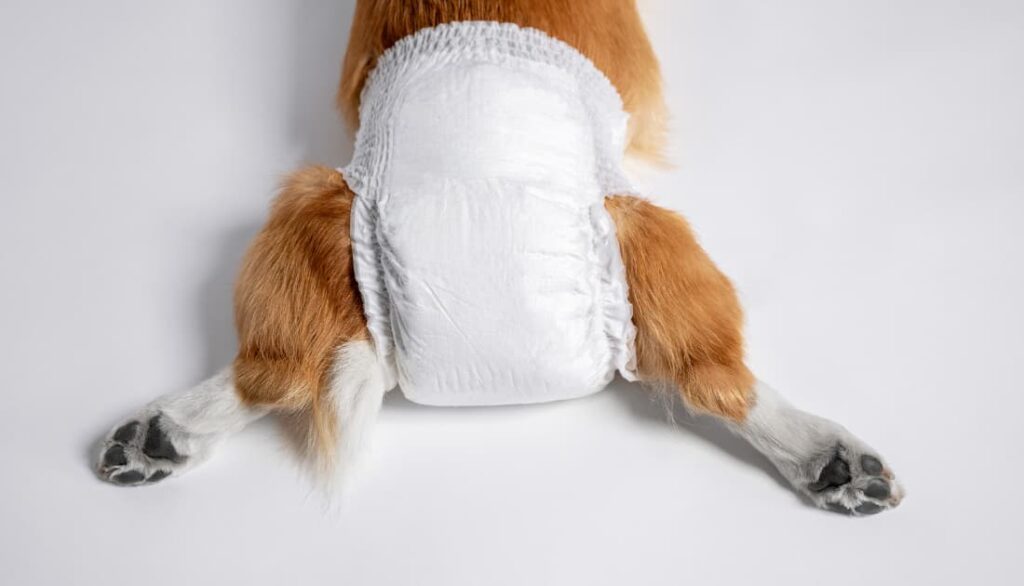
Remember that senior incontinence isn’t a sign of doggy revenge nor is it indicative of insufficient training.
It is a natural phase that demands empathy, adaptations, and generous love to support your aging dog through this transitional period.
Tackling Bed-Wetting Caused by Canine Territory Marking
To prevent your dog from marking their territory in inappropriate places, such as your bed, use these techniques to modify their behavior:
- Rule Out Medical Issues: Excessive or inappropriate marking could be a sign of an underlying health problem. Rule out medical conditions with a quick vet visit, that way you can focus on addressing any behavioral causes.
- Identify Triggers: Observe your dog’s behavior leading up to their marking incidents. Does it happen after new guests arrive? Have you recently moved furniture? Changes in the environment or encounters with other animals can trigger canine marking behavior.
- Neutering Your Dog– More beneficial in male dogs than female dogs, neutering your dog can help reduce unwanted behaviors. Studies suggest that neutering can reduce territorial marking by up to 50% in male dogs. This is likely due to a decrease in testosterone levels.
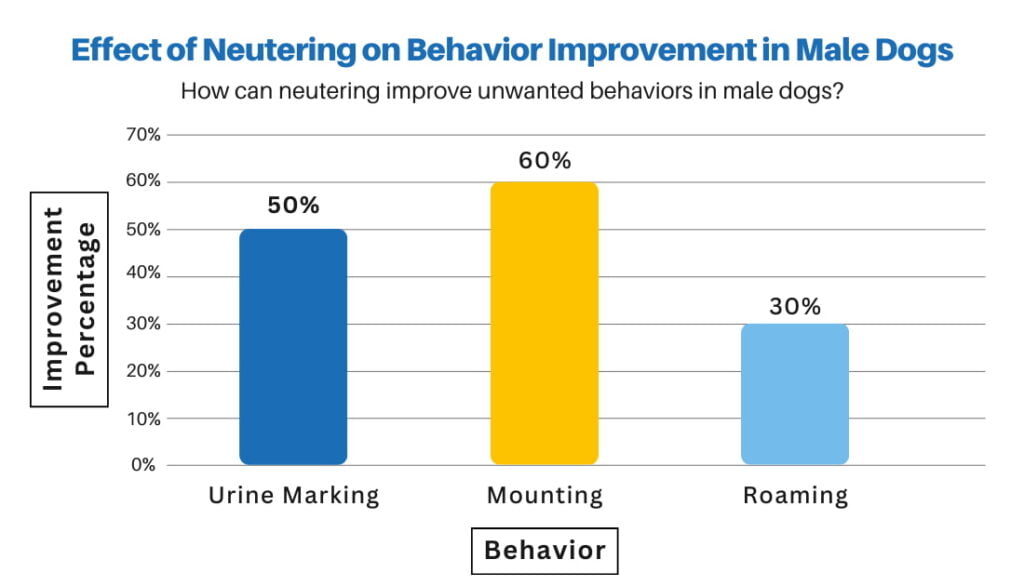
- Clean Up Messes: If your dog has an accident, use enzymatic cleaners to break down the pee scent. Avoid using cleaning chemicals such as ammonia or vinegar, as they attract your dog’s attention and amplify the scent mark. By using enzymatic cleaners, you can discourage your dog from revisiting the spot.
- Encourage Marking Outside During Walks: Allowing your dog to mark outside during walks helps to satisfy their marking instincts. Choose designated spots on your regular route and praise your dog for marking there.
Managing Dog Pee Problems Arising From Fear and Stress
When dealing with urination caused by stress or fear, it is crucial to identify, create, and minimize the issue.
Identify
Determine the time when your dog urinates on the bed.
Does it happen when you’re getting ready to leave the house or perhaps after a loud event in your neighborhood?
These observations can offer valuable insights into the causes of your dog’s anxiety and the resulting behavior.
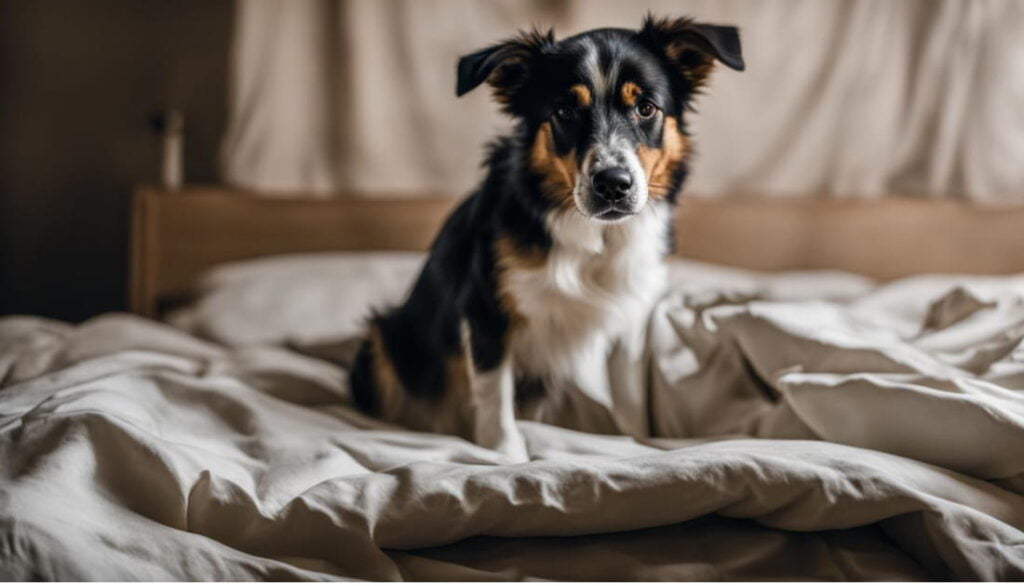
Create
Make a safe and secure environment for your pup during these stressful moments, such as:
- Loud Noises (Thunderstorms, Fireworks):
- Safe Space: Designate a quiet, windowless room or cozy den filled with familiar items like their favorite bed or blanket.
- Sound Distraction: Play calming music or use white noise machines to drown out the sound of the thunder.
- Comfort Items: Provide their favorite toys, a worn T-shirt with your scent, or calming anxiety wraps to offer security.
- Calming Products: Consider pheromone diffusers or herbal remedies recommended by your vet.
- Separation Anxiety:
- Gradual Departures: Ease them into your absence by practicing short “goodbyes.” Then, gradually increase the duration each time.
- Interactive Toys: Whenever your dog is left alone, keep them mentally stimulated with puzzle toys or food dispensers.
- Calming Supplements: Discuss natural calming supplements or anxiety medications with your dog’s veterinarian.
Minimize
While it’s impossible to completely eliminate all sources of stress in your dog’s life, you can minimize their impact by changing your dog’s emotional response to the particular stressor.
The idea is to replace an undesirable reaction with a more positive one. To do so, you can use various strategies, such as:
Counterconditioning and Desensitization
One way to help your dog overcome their fear of something is through gradual positive exposure.
For example, if your dog is afraid of storms, you can play recordings of thunder at a low volume while rewarding your dog with treats and playtime. You want to make sure your dog consistently reacts calmly to a volume level before increasing the volume. Over time, the gradual exposure will help your dog remain relaxed and happy when future storms occur.
This approach can help your dog form positive associations with the trigger rather than fear.
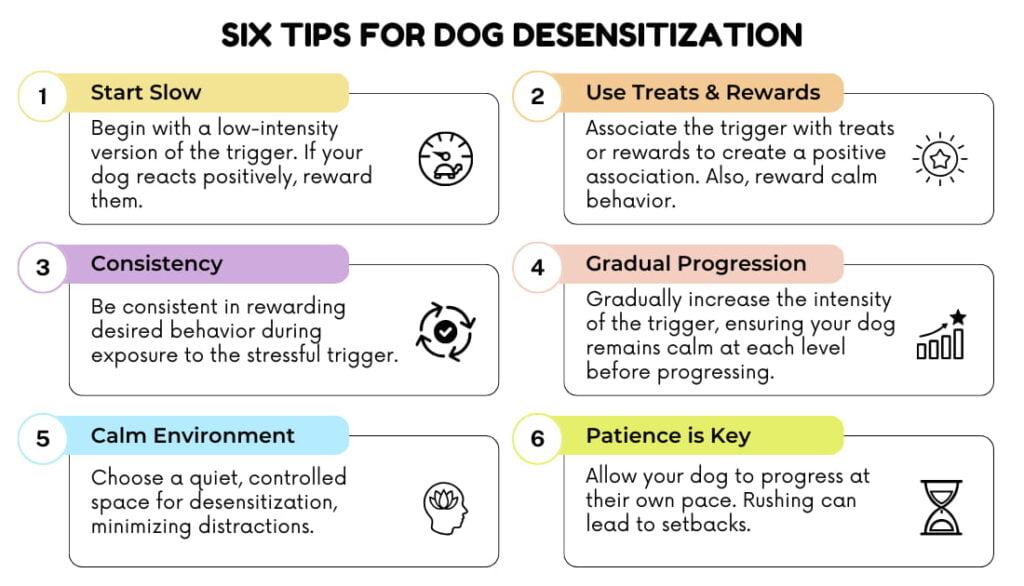
Exercise and Mental Stimulation
- A tired dog is a happy dog! Regular exercise and dog sports help release pent-up energy and reduce anxiety.
- Engage your dog’s mind with puzzle toys, food dispensing toys, training sessions, or sniffing games. Keeping them mentally stimulated can tire them out and alleviate anxieties.
The overall goal is to make a stressful situation more favorable for your pet. Also, keep going even if progress is slow! The right approach will bring significant improvements over time.
Mental Stimulation as a Key to Stop Peeing Accidents
Analyze your dog’s daily routine. Do solo hours lead to boredom? Are walks more repetitive than adventurous? Does interactive play happen only on occasion?
If your answer is yes to any of these, it’s time to crank up the playtime! Start engaging your furry friend in more enriching activities like:
Interactive play: Instead of repetitive walks, choose fun activities for your pet, such as treasure hunts, scent work, frisbee sessions, agility courses, or hide-and-seek with their favorite toys.
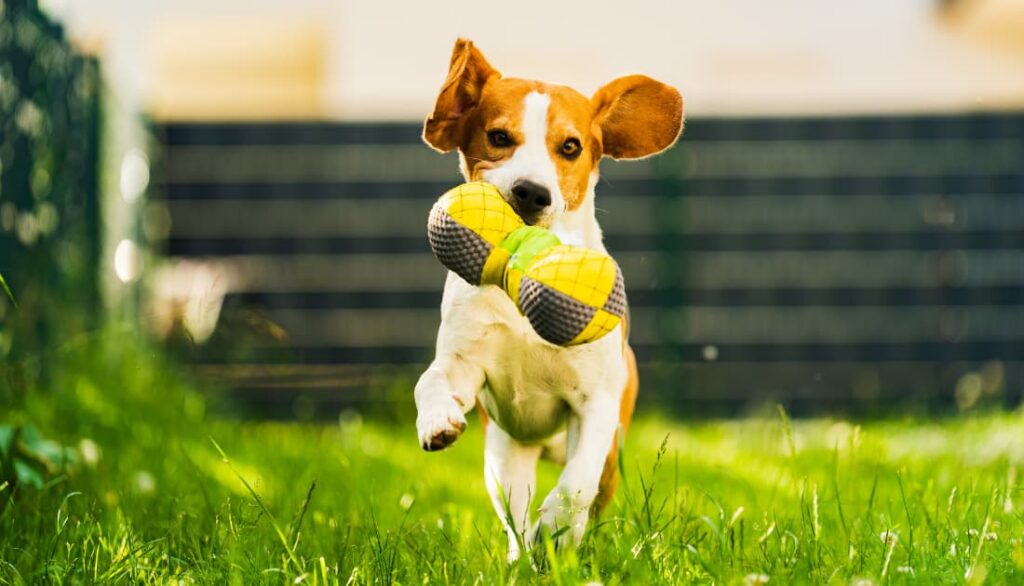
Companionship: Consider doggy daycare, pet sitters, or dog walkers if your workday is long.
Mental Stimulation: Keep your pet mentally stimulated by rotating their toys, teaching them new tricks, or hiding treats around the house for them to discover.
Socialization: Schedule playdates with other dogs or enroll in group training classes.
Keeping your dog busy can create a more stimulating and fulfilling environment for your pup. In turn, you will reduce the likelihood of bed-wetting driven by boredom.
Effective Steps to Ending Submissive Dog Urination
Dealing with submissive urination in your dog can be challenging. But with patience and empathy, you can create a calmer environment and boost your dog’s confidence. This can ultimately lead to fewer accidents.
According to veterinary research, you can use the following helpful strategies to address submissive urination in your dog effectively.
- Do not scold your dog after an accident. Punishment like yelling amplifies anxiety and worsens the issue.
- Choose to pet your dog under the chin instead of on top of the head.
- When giving your dog attention, lower yourself to their level to avoid appearing threatening when standing over them.
- Refrain from prolonged direct eye contact and approach your dog from the side rather than directly in front of them.
- If your dog urinates out of excitement or submission when you return home, wait 5 minutes for them to calm down before giving them attention.
As a result, submissive urination can be resolved with time and a tailored approach. By building your dog’s confidence, they can eventually leave the fear puddles behind.
Addressing Medical Needs: Working with Your Vet

As caring dog owners, we want to keep our furry friends happy and healthy. But since they can’t tell us exactly what’s wrong, we have to be alert and attentive to their well-being.
This is especially important when it comes to unusual changes in their behavior, such as urinating on your bed.
Thus, the chart below helps you understand common medical conditions that cause unusual dog urination. The hope is for you to feel more informed when discussing your dog’s inappropriate urination with their vet.
| Medical Issue | Symptoms | Potential Treatment |
|---|---|---|
| Urinary Tract Infection (UTI) | Frequent urination (small amounts), straining, blood in urine, licking genitals | Antibiotics |
| Bladder Stones | Frequent urination (sometimes bloody), difficulty urinating, abdominal pain, crying during urination | Dietary changes, medication (e.g., antibiotics), surgery |
| Diabetes Mellitus | Increased thirst and urination, weight loss, increased appetite, lethargy | Insulin injections, dietary changes |
| Kidney Disease | Increased thirst and urination, lethargy, vomiting, loss of appetite, weakness | Dietary changes, fluids, medication |
| Neurological Issues | Difficulty walking/standing, loss of bladder/bowel control, muscle weakness, pain | Medication, surgery, physical therapy |
| Hormonal Imbalances | Changes in urination (frequency, amount), appetite/weight, lethargy, skin problems | Medication, surgery (rare) |
Note: This chart does not replace professional veterinary advice. If you observe any unusual changes in your dog’s urination habits, make an appointment with your vet for a proper diagnosis and treatment plan. Early intervention can significantly enhance your dog’s well-being and prevent further complications.
Long-Term Strategies to Keep Your Bed Dry
As the saying goes, “prevention is better than cure,” and this couldn’t be truer regarding our dogs’ health.
When it comes to your canine companion peeing in the bed, proactive measures can save you a lot of stress (and laundry). Explore these expert-proven strategies that you can use to minimize the risk of your dog peeing on the bed.
Restricting Access to the Bed (Utilizing Crates and Gates)
Dogs thrive on clear boundaries, and one of the most effective ways to prevent bed wetting is to restrict your dog’s access to your bed.

Many think crates are only used for punishment or confinement, but it’s false. If set up correctly, they can become a cozy den for your pet to retreat to.
This can give your buddy their personal space while preventing them from getting on the bed during potty training.
Tip: Picking the correct crate size is essential. Choose a large enough crate for your dog to stand up, turn around, and lie down comfortably, ensuring it becomes a positive space.
Another way you can block access to your bed is with gates. By strategically placing gates, you can reinforce the message that the blocked-off area is a “no-pee zone.”
But don’t just pick any gate!
Choose sturdy, escape-proof gates that can withstand even your dog’s most enthusiastic escape attempts. These gates should act as gentle reminders rather than deterrents.
Supervision and Intervention Techniques for Dog Potty Success
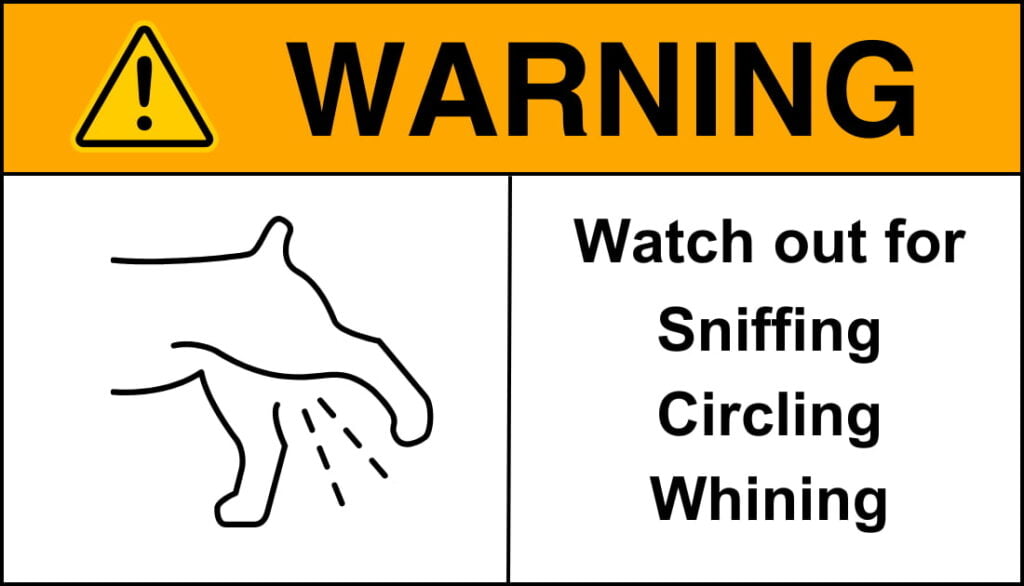
In addition to physical barriers, supervision can also prevent your dog from peeing on your bed. Keeping an eye on your dog’s behavior allows you to intervene before an accident occurs.
By understanding your dog’s “I have to pee” signs (sniffing, circling, or whining), you can quickly take your dog outside just in time.
Therefore, you can utilize the following intervention techniques to reinforce appropriate potty habits and maintain the bond between you and your pet.
| Intervention Technique | Description | Purpose |
|---|---|---|
| Redirecting on Approach | Gently leading away from the bed when attempting access | To associate the act of approaching the bed with redirection |
| Command and Praise | Using commands like ‘No’ with immediate redirection and praise for correct behavior | To reinforce desired behavior through positive feedback |
| Observation Periods | Watching closely after meals, play, and nap times | To anticipate and prevent potential accidents |
| Designated Potty Breaks | Regulated outdoor breaks specifically for elimination | To establish a consistent routine and proper location for elimination |
Seek Professional Help from a Vet or Behavioral Therapist
Let’s say you’ve put in weeks (or even months) of diligent training and bathroom breaks, but your canine companion is still turning your bed into a personal toilet.
It’s time to seek professional help, either from a veterinarian or an experienced animal behaviorist. A vet can eliminate any potential medical reasons behind the behavior, such as urinary tract infections or bladder problems.
But if you find that your dog is physically healthy, then enter the animal behaviorist. These canine whisperers are skilled at interpreting doggy body language and discerning behavioral issues that may be causing undesired actions like bed-wetting.
Key Takeaways
Understanding the Reasons:
- It’s important to understand that dogs may pee on your bed due to house training mishaps, medical issues, stress, fear, boredom, or territorial marking. Their actions are not motivated by malice or ill will.
Address the Root Cause:
- Implement consistent potty training techniques, get your dog checked out for potential health issues, manage anxiety, or counter boredom with mental stimulation to address the root cause.
Patience and Empathy:
- Avoid punishment as it is counterproductive. Foster trust and create a secure and safe environment for your pets, especially during stressful situations. You are reducing the likelihood of inappropriate urination.
Multi-Strategic Approach:
- Restrict bed access, supervise vigilantly, address emotional needs, provide engaging activities, and use targeted interventions to increase success.
Professional Guidance:
- Seek help from trainers and behaviorists, especially if you notice your dog is behaving weirdly. Their expertise can provide valuable guidance and personalized plans to help stop your dog from peeing the bed.



